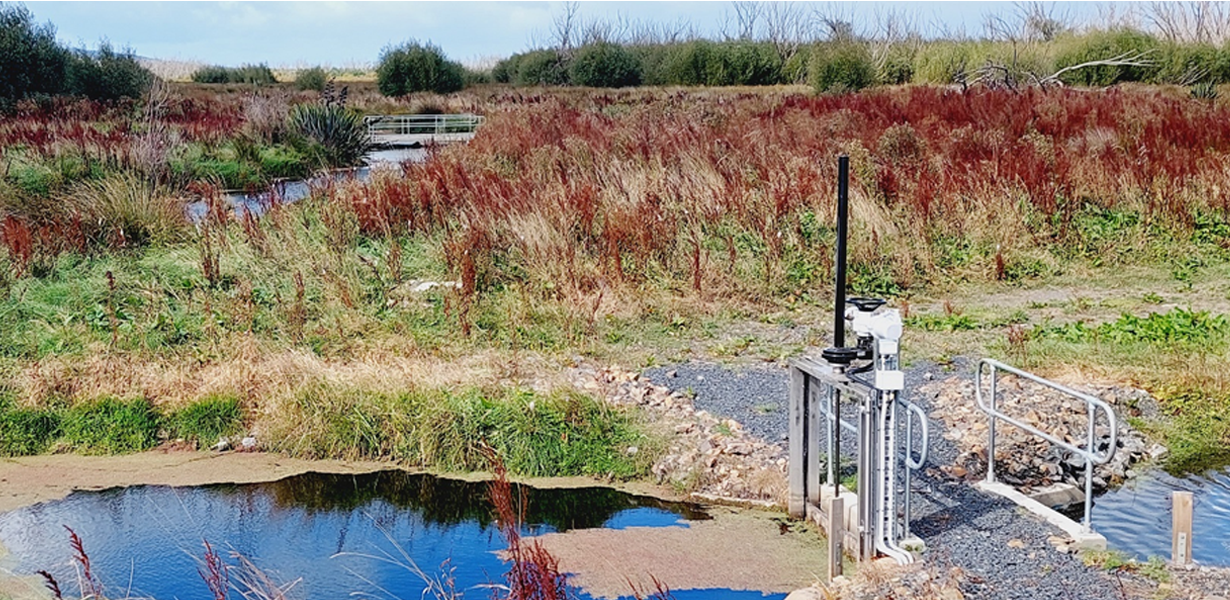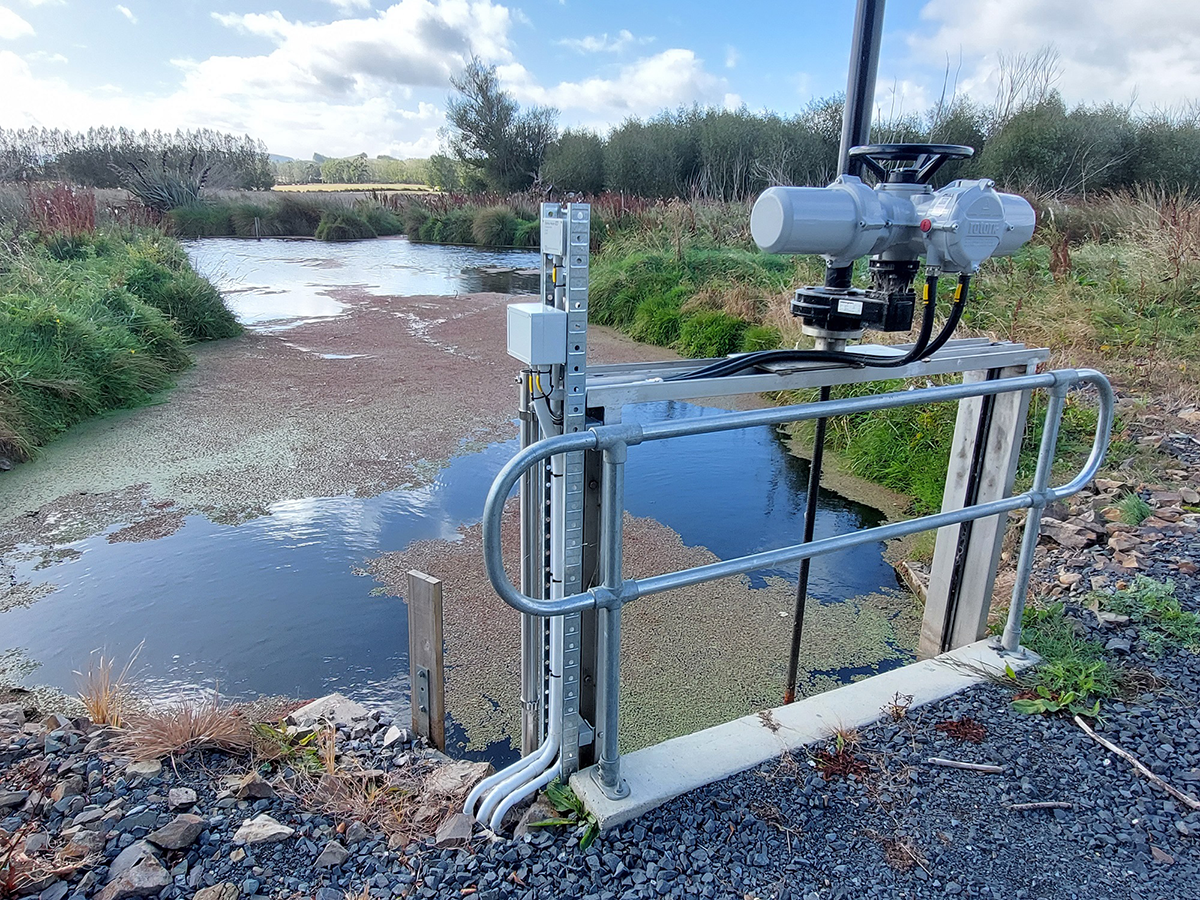The wetland and Lake Tuakitoto area has been recognised as a Regionally Significant Wetland for its high diversity of indigenous flora and fauna, hosting a range of nationally or internationally rare or threatened species, including about 50 bird species and also threatened galaxiid (whitebait) populations.
The area is considered a regionally and nationally important habitat for waterfowl, waders, swamp birds and galaxiids and is a remaining example of what was once a widespread type of wetland.
The official opening, blessing and community day is scheduled on site for 19 April. Invitees include ORC Councillors local MPs Rino Tirikatene, Rachel Brooking and Ingrid Leary, plus representatives from project co-partner the Ministry of Business, Innovation and Employment (MBIE) and its Regional Economic Development & Investment Unit, Kānoa.

The new flow gate, and background, a new vehicle crossing. Photo: ORC/Tim Ware
Robson Lagoon is in the Clutha-Mata Au catchment, about 7 kilometres northeast of Balclutha. It is a key part at the head of the regionally significant Lake Tuakitoto Wetland complex, which is within the ORC’s catchment of the Lower Clutha Flood Protection and Drainage Scheme.
Project co-funded by MBIE and ORC
The $835,000 project is co-funded by the MBIE and the ORC; MBIE’s contribution is from Kānoa’s Covid Response and Recovery Fund, widely referred to as the ‘Shovel Ready’ Infrastructure Projects fund.
The lagoon, lake and wetlands is described as a rush and sedge swamp, lowland lake, with an artificial water level.
ORC Manager Engineering Michelle Mifflin says the aim of the project is to change the flow management system around the wetland to encourage the normal flows of tributaries Lovells
Stream and Stoney Creek which enter Robson Lagoon, while managing drainage in the area.

The flow gate and its solar powered actuator valve. Photo: ORC/Tim Ware
She says the project not only upgrades ageing infrastructure, which will assist with water management around the 566-hectare lagoon complex but will also enhance protection of its natural and ecological values.
“The new flow management structures will allow for sustainable habitat water levels and flows and also provide for the safe passage of native fish with a small tunnel for them,” she says.
Fish have free passage when the gate is open, but there is also now a tunnel/drain for them to use during low flows.
The gate is opened when there are higher flows from the tributaries, with water is diverted past the lagoon through a drain into the lake, and in lower flows the gate is closed and the tributaries can flow into and replenish the lagoon.
An old, gated culvert and other ageing structures have been removed and replaced with the new gate, a lagoon (vehicle track) crossing and a separate sandbag weir have been upgraded and a flap-gate culvert at the confluence of Stony Creek has also been installed.
“This project will go a long way to providing certainty in maintaining minimum water levels for the wetland and also provide adequate land drainage,” Ms Mifflin says.
The solar powered flow gate, and its valve actuator, will automatically control the water flow levels, by raising and lowering the gate, which will keep the lagoon at a steady level, she says.

Robson Lagoon in ORC’s Clutha-Mata Au catchment, near Balclutha. Photo: ORC/Tim Ware
Habitat for nationally/internationally rare or threatened species
There is a highly diverse “mosaic” of vegetation types and wildlife habitats in the area, hosting nationally or internationally rare or threatened species or communities, she says.
Ms Mifflin encourages people to use the public walking track around the lagoon, which is now preserving the flora and fauna of a wetland system; once common throughout Otago.
The area provides roosting, feeding and breeding habitat for the threatened Australasian Bittern and Banded Dotterel and is also a breeding area for the uncommon Marsh Crake, Spotless Crake, and South Island Fernbird.
It also supports a significant proportion of the national population of Mallard and New Zealand Shoveller/Kuruwhengi, Grey Teal and Black Swan.
“All these bird species breed here. It’s also considered nationally important as a freshwater fishery habitat too,” she says.
The area supports long and shortfin eels, whitebait/inaka, the common bully/pako as well as the giant kokopu galaxiid and freshwater mussels and offers a recreational fishery for perch and brown trout in some places. It also hosts the threatened plant species swamp nettle and Isolepis basilaris, which are present on swamp margin, she says.
Project consultation
Also involved with the project and consultation has been the landowners, Aukaha, Fish and Game and the Department of Conservation, she says.
Ms Mifflin says the area is significant for Kai Tahu for cultural and spiritual beliefs, values and uses, including mahika kai and waahi taoka.
“The wetland is highly valued by Kai Tahu for its historical associations, and also as a traditional food gathering area,” she says.
In New Zealand’s Top 10 Wetland Wildlife Habitats
The wetland is owned as endowment land by the ORC and covered by a conservation notice. It is identified in the ORC’s Regional Plan: Water for Otago as a Regionally Significant Wetland and is listed as a Significant Wetland in the Clutha District Plan.
Ms Mifflin also highlighted that it is described as number five in New Zealand’s Top 10 Wetland Wildlife Habitats.
“Less than 15% of Otago’s original swamps still remain,” Ms Mifflin notes.
Background
Lake Tuakitoto and surrounding wetlands perform a valuable hydrological function, serving as a natural flood ponding area; an otherwise integral part of the Lower Clutha Flood Control and Drainage Scheme, Ms Mifflin says.
Consent was approved in 2020 and the conditions imposed include maintaining fish passage and a baseline assessment of fish populations, plus ongoing monitoring and reporting.
Aside from the flow gate, other project works included installation of a flap gate culvert at Stoney Creek, replacement of a sandbag weir at the lagoon’s eastern side and the replacement of the existing culvert vehicle crossing with new box culverts.
Alongside input of ORC’s Engineering team, the work was completed by Fulton Hogan, Calibre, Ryder Consulting, and Mitchell Daysh.
Media are welcome to attend the opening, from 12-2pm on 19 April.
